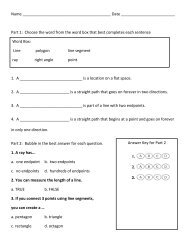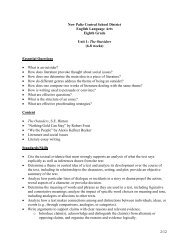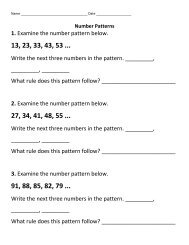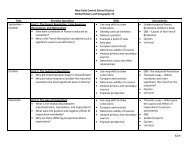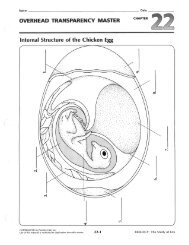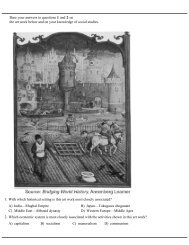N.Y.S Anti-Idling Law & Regulation
Anti-Idling Bus Driver Training - New Paltz High School
Anti-Idling Bus Driver Training - New Paltz High School
- No tags were found...
You also want an ePaper? Increase the reach of your titles
YUMPU automatically turns print PDFs into web optimized ePapers that Google loves.
N.Y.S. <strong>Anti</strong>-<strong>Idling</strong> <strong>Law</strong> &<br />
<strong>Regulation</strong><br />
Chapter 670 <strong>Law</strong> of 2007 bans idling of school<br />
buses on or adjacent to school grounds =<br />
Education <strong>Law</strong> 3637<br />
8 NYCRR 156.3 (h) establishes school district<br />
responsibility and bus driver requirements.<br />
Notice: To all school personnel within 5 days of<br />
school start.<br />
NYSED 2008 <strong>Anti</strong>-<strong>Idling</strong> for School Buses 1
Education <strong>Law</strong> section 3637<br />
Requires School Districts to:<br />
• Minimize school bus idling<br />
• Engines to be shut off while waiting for<br />
passengers to load<br />
• Applies to all school vehicles<br />
• Owned, leased or contracted for<br />
• While parked or standing on school<br />
grounds or in front of any school<br />
• Annually provide notice to employees<br />
NYSED 2008 <strong>Anti</strong>-<strong>Idling</strong> for School Buses 2
8 NYCRR 156.3 (h)<br />
Requires School Districts & Drivers:<br />
• Shut off engines while waiting for<br />
students to load<br />
• Applies to owned, leased or contracted<br />
• While parked or standing on school<br />
grounds or in front of any school<br />
• Semi-annual: monitor driver compliance<br />
• Exceptions for safety, emergency and<br />
mechanical work.<br />
NYSED 2008 <strong>Anti</strong>-<strong>Idling</strong> for School Buses 3
<strong>Law</strong> & <strong>Regulation</strong>s Require School<br />
Bus Drivers to:<br />
1. Limit idling time during warm-up<br />
2. Park away from building fresh air intakes<br />
3. Park diagonally in school loading areas<br />
4. Instruct students to board the bus promptly<br />
in the afternoon to reduce loading time<br />
5. Turn the bus off during sporting or other<br />
events – relax inside until the event is over<br />
NYSED 2008 <strong>Anti</strong>-<strong>Idling</strong> for School Buses 4
What’s So Bad<br />
About <strong>Idling</strong> Anyway?<br />
• Diesel exhaust contains cancer causing substances!<br />
• Diesel exhaust contains particulate matter which<br />
exacerbates asthma and other respiratory conditions<br />
• <strong>Idling</strong> increases the amount of diesel exhaust entering a<br />
bus<br />
• Children are especially susceptible to diesel exhaust<br />
• Students walking by idling buses inhale large amounts of<br />
diesel exhaust<br />
• <strong>Idling</strong> buses often park under fresh air intakes at schools -<br />
causing diesel exhaust to be drawn into the school’s indoor<br />
air system<br />
NYSED 2008 <strong>Anti</strong>-<strong>Idling</strong> for School Buses 5
Impact of Diesel Exhaust<br />
on our Children<br />
Kids respiratory systems are still<br />
developing; they breathe faster<br />
taking in more air.<br />
Diesel exhaust has billions of small<br />
particles that become lodged in<br />
their lungs<br />
Can cause lung damage, aggravate<br />
asthma, bronchitis and other<br />
health problems.<br />
NYSED 2008 <strong>Anti</strong>-<strong>Idling</strong> for School Buses 6
Impact of Diesel Exhaust<br />
on our Health<br />
U.S. Environmental Protection<br />
Agency identified 21 harmful<br />
chemicals<br />
Pollutants in bus exhaust can cause<br />
or trigger lung cancer,<br />
cardiovascular disease, asthma,<br />
impaired immune function,<br />
decreased lung function and<br />
shortness of breathe.<br />
NYSED 2008 <strong>Anti</strong>-<strong>Idling</strong> for School Buses 7
Impact of Diesel Exhaust<br />
on our Community<br />
Adverse effects of diesel hurt the<br />
entire population not just children.<br />
<strong>Idling</strong> reduces crop yields.<br />
Acid rain damages trees and means<br />
fewer fish in lakes and streams of<br />
Adirondacks.<br />
Increases growth of algae and harms<br />
costal waters of Long Island Sound.<br />
Leads to increased hospital<br />
admissions, emergency room visits<br />
and lost time from work and school.<br />
NYSED 2008 <strong>Anti</strong>-<strong>Idling</strong> for School Buses 8
Common <strong>Idling</strong> Myths<br />
<strong>Idling</strong> Myth #1: Warm your bus up for 20-<br />
30 minutes before you start your route in<br />
the morning, so the engine will reach<br />
running temperature before you leave the<br />
yard.<br />
<strong>Idling</strong> Fact: Modern diesel engines don’t<br />
reach running temperature until they’re<br />
driven on the road.<br />
NYSED 2008 <strong>Anti</strong>-<strong>Idling</strong> for School Buses 9
<strong>Idling</strong> Myths<br />
<strong>Idling</strong> Myth #2: <strong>Idling</strong> longer than 5<br />
minutes before starting on your route is<br />
better for the engine.<br />
<strong>Idling</strong> Fact: Excessive idling increases<br />
engine wear and wastes fuel.<br />
NYSED 2008 <strong>Anti</strong>-<strong>Idling</strong> for School Buses 10
<strong>Idling</strong> Myths<br />
<strong>Idling</strong> Myth #3: Don’t shut your bus off<br />
during athletic events or field trips far from<br />
home, in case it won’t start.<br />
<strong>Idling</strong> Fact: A well-maintained modern<br />
bus will start every time – if a bus doesn’t<br />
start every time, it should be repaired.<br />
NYSED 2008 <strong>Anti</strong>-<strong>Idling</strong> for School Buses 11
Another <strong>Idling</strong> Myth<br />
<strong>Idling</strong> Myth #4: <strong>Idling</strong> is necessary to keep<br />
the cabin comfortable for the kids.<br />
<strong>Idling</strong> Fact: There are auxiliary heaters<br />
that can be purchased to heat up the bus.<br />
<strong>Idling</strong> is not an efficient way to heat the<br />
cabin. Routes should be planned to spend<br />
less time waiting.<br />
NYSED 2008 <strong>Anti</strong>-<strong>Idling</strong> for School Buses 12
A Final <strong>Idling</strong> Myth<br />
<strong>Idling</strong> Myth #5: There’s no way to avoid<br />
exposure to diesel exhaust when our buses<br />
line up in the school loop for afternoon<br />
dismissal.<br />
<strong>Idling</strong> Fact: There’s no need for bus<br />
drivers to line up so early in the school<br />
loop, or to leave their engines running while<br />
waiting for afternoon dismissal to begin.<br />
NYSED 2008 <strong>Anti</strong>-<strong>Idling</strong> for School Buses 13
All Rules<br />
Have Exceptions…<br />
<strong>Idling</strong> may be necessary in certain<br />
conditions, including:<br />
• Occupant safety and comfort when temperature is<br />
below 20 degrees F<br />
• For Mechanical Work - or to defrost the<br />
windshield for visibility<br />
• Emergencies - need to run the wheelchair lift<br />
NYSED 2008 <strong>Anti</strong>-<strong>Idling</strong> for School Buses 14
Financial Impact<br />
of Excessive <strong>Idling</strong><br />
• Increased fuel costs –<br />
idling buses can<br />
consume ½ gallon of<br />
fuel an hour, or more<br />
• More frequent oil<br />
changes<br />
• Higher maintenance<br />
costs<br />
• Decreased engine life<br />
NYSED 2008 <strong>Anti</strong>-<strong>Idling</strong> for School Buses 15
You can play a big role in improving<br />
children’s health and the environment<br />
NYSED 2008 <strong>Anti</strong>-<strong>Idling</strong> for School Buses 16
Thank You<br />
NYSED 2008 <strong>Anti</strong>-<strong>Idling</strong> for School Buses 17




